GENERAL
Conforming is the pocess of loading an external edit list into SCRATCH, match that with the actual media and then create a new timeline. SCRATCH can handle different formats of an edit list:
- EDL - Edit Decision List - A standard text file that is generated from the offline system and provides SCRATCH with information about the source time code, name and/or reel-id for each shot in the timeline. It also provides a record time code that describes where the shot is located within the timeline.
- ALE - AVID Log Exchange - File format primarily focused on exchange of metadata rather than conforming a timeline.
- AAF - Advanced Authoring Format - An industry standard Edit Protocol that provides both (multi-layer) timeline and composite (image effects) information
- XML - Extensible Markup Language - This file format is exported by Apple's Final Cut Pro software. It can include multiple tracks and image filter/effect descriptions.
You use the Load Conform button on the Media menu to open an edit list. The button opens a SCRATCH Browser with which you can navigate to the location and select a conform file.

Depending on the selected file format a dialog will open showing the edit events or metadata. The dialog allows you to match the events with shots and assemble a new timeline. Each of the EDL, AAF and XML conform functions have the option to insert Placeholder for events in the Edit list for which no media can be found. You can replace the Placeholder on a later moment by using the Placeholders button and starting the Match and Replace Placeholder dialog.
EDL
An EDL is a text base format where SCRATCH supports EDLs in the CMX 3600 layout. A typical EDL is formatted like this:
TITLE: MY_SCRATCH_DI
FCM: NON-DROP FRAME
001 BL V C 00:00:00:00 00:00:10:00 01:00:00:00 01:00:10:00
FROM CLIP NAME: RPT-BLACK
002 STK01 V C 01:02:00:00 01:02:55:09 01:00:10:00 00:01:05:09
FROM CLIP NAME: ANIM_01
003 VT012 V C 12:02:19:11 12:02:38:04 00:01:05:09 00:01:24:02
FROM CLIP NAME: POE_09_v22
004 VT007 V C 07:02:51:02 07:02:57:08 00:01:24:02 00:01:30:08
FROM CLIP NAME: POE_11_v17
005 VT018 V C 18:03:16:03 18:03:23:18 00:01:30:08 00:01:37:23
FROM CLIP NAME: POE_15_v08
When loading the EDL in SCRATCH the EDL Assembler opens.
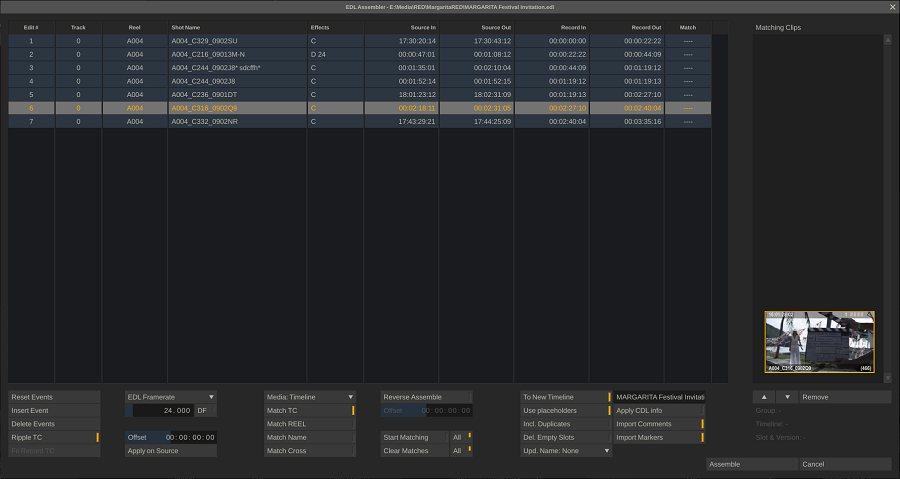
The Assembler allows you to edit the EDL events and offers control over how to match the EDL with media and how to generate the timeline.
EVENT GRID
The Event Grid displays every event in the EDL on its own row. Clicking a column header will sort the list based on that column’s information. Clicking the same header again will reverse the sort from ascending to descending. Note though that the timeline is created based on the order of the EDL event numbers in the first column - regardless of the current sort order.
The Reel-ID, Clip Name and Timecode can be edited by clicking on a cell in the selected row. Updated values are shown in yellow to identify changes from the original.

The Effects column shows clip transitions (Cut/Dissolve), vari-speed (FPS) and flip/flops (Mirror-Y/Mirror-X).
If an event has invalid timecode or zero length timecode, the row will show disabled.
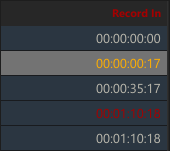
If data is lost because of timecodes conversion with the wrong frame rate, the row will show disabled and the frame rate button below the grid will show red to indicate that there is an issue within the EDL.
The Match column shows a letter code that indicates based on which properties a shot was matched with the EDL event:
- T = Timecode match
- R = Reel match
- N = Clip name match
- C = Reel/Name Cross match
- The number of matches is indicated by the value shown after the match indicators.
The following Quick Keys can be used in the event grid:
|
• Quick Key: Control + A
|
» Select all rows
|
|
• Quick Key: Control + D
|
» Deselect all rows
|
|
• Quick Key: Control + Left Mouse Click
|
» Add or remove row in selection
|
|
• Quick Key: Shift + Left Mouse Click
|
» Select all rows between selected row and current selection
|
|
• Quick Key: Spacebar + Left Mouse Click
|
» Pan through the Event Grid
|
EDIT CONTROLS
The Edit controls allow you to modify the current EDL using the following commands:
Reset events
Reset the selected events to their default values.
Insert event
Add a new EDL event before the currently selected event. The new event has a Source Timecode of zero, so initially the row will be shown disabled. The Record Timecode of the new event will match the outgoing timecode of the preceding event and the incoming timecode of the next event.
Delete events
Delete all selected events.
Ripple TC
When active, this will ripple the record timecode on all events after the current event. An increase of the outgoing timecode of the current event will update in- and out- record timecode of all events after. Before increasing the timecode of the next event, first any existing gaps between the outgoing timecode of an event and the incoming timecode of the next event will be closed. Note that this option does not take a multi-track EDL into account. Multi-track EDL can have overlapping record timecodes. Updating a timecode can as such have consequences for the timing of other tracks. Check with the source of the EDL if it indeed has multiple tracks before adjusting the record timecode.
Fit record
Updates the record timecode of selected event to match the record in-and out- of events before and after the selected event. This is used to automatically fill any record discontinuities in the timeline by extending the selected event to fill in the discontinuity.
Frame rate
Sets the frame rate for the EDL. When changing the frame rate, all the original timecodes from the EDL will be converted. When the conversion causes a loss of data, the event will show as disabled and the frame rate button will appear red. If the EDL is assembled to a new Construct, the frame rate will be set as the default for that Construct.
Offset and Apply on Source
Add an offset to the source timecode of all selected events. The offset will be added to both the in- and out- timecodes.
MATCHING OPTIONS
At the core of the assemble process is the matching process between the events in the EDL and the shots loaded in SCRATCH. The process will compare the source in- and out- points of an event and shot and determine if there is an match/overlap. The process will also compare shot name and reel-ID of the event and a shot, as well as check whether the shot name of the event matches the reel-ID of a shot. The process might find zero, one or more matching shots. If more than one matching shot is found, SCRATCH will sort the matches giving preference to clips that have been graded and clips that are currently on or closer to the timeline in the source Construct. There are a number of controls to adjust this matching process to your specific situation.
Match from…
Determines the location where SCRATCH will search for matching shots. The available options are: (current)Timeline, Group or Project.
Match TC
Source shots must have a timecode overlap with the EDL event to successfully match. If switched off, the overlap will still be used for ranking multiple matches.
Match Reel
The source shot’s reel-ID must match with the EDL tape-ID to successfully match. If switched off, the match will still be used for ranking multiple matches.
Match Name
The source shot’s clip name must match with the From Clip Name comment in the EDL to successfully match. If switched off, the match will still be used for ranking multiple matches.
Match Cross
Either the source shot’s reel-ID must match with the From Clip Name comment in the EDL or vice versa to successfully match. If switched off, the match will still be used for ranking multiple matches.
Reverse Assemble
This feature is used for splitting a single clip into several events using the Record In and Out points from the current EDL. All events are matched with the first clip on the current Construct and assembled accordingly. The Offset value allows you to set a difference between the source clip’s timecode and the Record timecode in the EDL in order to get a correct assemble. Note that the timecode of each newly created clip is updated to the (source)timecode from the EDL.
Start Matching (All)
This button starts the matching process, using the match options set. If the [All] button is enabled, the process will process all events, starting with the topmost event which was not processed yet. If the [All] button is disabled then only the current event is processed. Once the matching process is started, the function of this button will change to Abort the process and a progress indicator will appear at the right of the button. You can stop the matching process at any time. You can also change the match options during the process, this will cause all events processed so far to be re-matched based on the new options. The matching process will not remove any previously matched clips from the list, even if they are not compatible with the new matching options.
Note: When changing the match properties, already found matching clips will not be removed from the list but remain as valid matches. This way you can gradually relax matching criteria or expand the matching domain (project, group, Construct) without losing already matched clips. Matches are ranked (see below).
Clear Matches (All)
This button will clear the list of matching clips of the current selected event or, in case the [All] button is enabled, of all events in the EDL. This way you can start a new, clean matching process based on current matching options.
ASSEMBLE OPTIONS
To New Timeline
When active, the EDL will be assembled into a new Construct. When inactive, the EDL will be assembled into the current Construct. When assembling to the current Construct, if the current Construct has a different frame rate than selected in the Assembler, a warning will be displayed next to the Construct text slate showing the frame rate mismatch in red. You can still assemble to the current Construct which has the different frame rate. The Record timecodes in the EDL, which are used to set the slot length, are converted to the frame rate of the current Construct. The matching algorithm and source timecodes remain unchanged. The newly assembled clips will be placed at the bottom of each slot’s layer stack and any existing clips will be pushed up in the layer stack.
When assembling to a new Construct, the default name for a new Construct is the name of the EDL file. You can modify this by typing a new name in the text slate below the To New Timeline button.
Use Placeholders
This option will insert a placeholder clip in the timeline for each event that does not have a matched clip tied to it. The placeholder clip will inherit all EDL metadata (timecode, name, reel). With that you can perform a Placeholder conform on those placeholder clips at a later time to update the timeline.
Incl. Duplicates
When this button is active all matches will be added to the new conform. This allows you to bring any matching clips into the new Construct in case there is a need to examine the matches more closely to determine which version to use.
Delete Empty Slots
When active, any events in the EDL which have no matching clips will not be created in the final assemble. When disabled, an empty slot of the proper duration will be created in the final assemble.
Note: Timecode gaps in a Reverse Assemble are automatically filled.
Update Name
With this option the name of the matched clip that is assembled into the timeline is updated to the specified value; either the name or reel as included in the EDL or to the text of the first marker tied to the EDL event. Markers are annotations from the Avid Media Composer editor.
Apply CDL Info
An EDL may contain ASC CDL (Color Decision List) information. If so, SCRATCH will parse that information and with the Apply CDL button you can translates and apply the info to the SCRATCH color pipeline of a shot. The CDL information in an EDL is included in the comment lines with either a ASC_SOP (Slip Offset Power) or ASC_SAT (Saturation) keyword at the beginning of the line and (if applicable) the values split into RGB (red, green, blue) values like this:
* ASC_SOP = (1.000000 1.000000 1.000000) (0.000000 0.000000 0.000000) (1.000000 1.000000 1.000000)
* ASC_SAT = (1.000000)
The ASC CDL parameter mapping to the SCRATCH color pipeline is implemented as follows:
ASC CDL -> SCRATCH
Slope -> Pre-Gain (r,g,b)
Offset -> Offset (r,g,b)
Power -> Gamma (r,g,b)
Saturation -> Color-B Saturation
Import Comments
Import any comments in the EDL event as annotations in the assembled shot.
Import Markers
Markers are annotations from the Avid Media Composer editor that can be included in an EDL. A marker contains a label, a color and a timecode (offset). This option imports the markers as annotations with the shot into SCRATCH.
Assemble
Perform the assemble and close the Assembler.
Close
Closes the Assembler without performing an assemble. The state of the Assembler is preserved as long as you remain in the current project and you do not click the Clear EDL button. The EDL can be opened from a different Construct. This way an EDL can be matched with specific Constructs in different Groups.
MATCHING CLIPS
The section on the right side of the Assembler shows any matching clips for the selected event in the EDL. The clip on the bottom of the stack is initially the best match. The matching routine ranks possible matches. The ranking is based on timecode, Reel-ID and Clip name –favoring the clip that has grading and favoring the clip closest to the timeline, i.e. bottom of the version stack.
You can select a clip in the stack and use the arrow buttons just below the Matching Clip window to change the order of the clips. The label at the top of the window will change to yellow to show that the order has been altered from the original match. Whichever clip is on the bottom of the stack is the one that will be used in the assemble.
You can click on the Nt. button to toggle the sticky notes on and off for the matching clips, which can be used to further identify the proper clip for a conform. The Delete Match button can be used to remove a selected clip from the Matching Clips window. There moved clip will no longer be used in the assemble for that event. The current location of the selected matching clip is shown below the Matching Clips window and includes the source Group, Construct, Slot and Version position.
ALE IMPORT
The ALE (AVID Log Exchange) Import dialog allows you to import metadata and (optionally) conform a new Timeline. An ALE is a text file with a header section and a tab-separated data section. The exact specifications of an ALE is publicly available on the AVID website www.avid.com. Even though importing an ALE has a lot in common with processing an EDL, it has some specific functions.
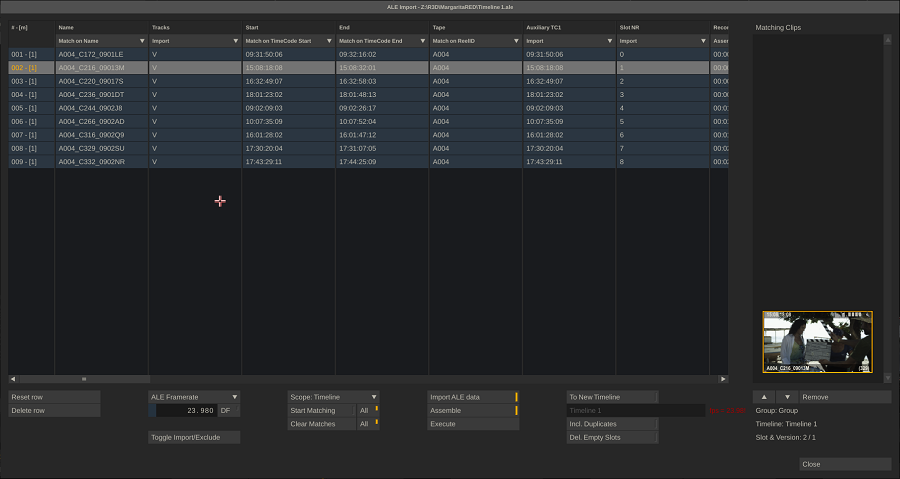
Processing an ALE is a three step process:
- Load the file and link the data-columns in the file to set the usage of each data-column
- Match the ALE entries with shots in the SCRATCH project
- Either import the metadata, conform a new timeline or do both
SET COLUMN USAGE
All the data in an ALE is presented in a grid in the dialog. The first row of the grid shows the name of each column. By clicking on the second row a option list appears; allowing you to change the usage of the column in the ALE processing function.
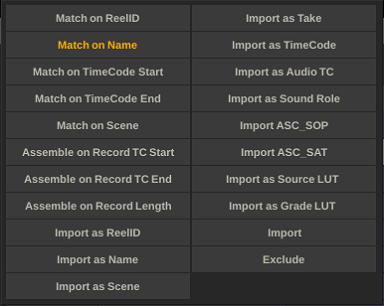
Each column is either:
- Used in the matching process through the Match.. options
- Used for assembling of a new timeline through the Assemble.. options
- Imported to update a specific shot property through the Import as.. options
- Imported to update the color pipeline settings. Select one of the Import ASC.. options
- Imported to update or added as a general metadata item in the name-value list of a shot. Select the plain Import option
- Excluded from the ALE process through the Exclude option
If an ALE includes a column that is called e.g. shotName and you would like to use that for matching the ALE events with the shots in the project, you need to select the Match on Name option. If you want to use this column to update the name property of the shots in your project with (while matching on other criteria), you would select the Import as Name option. In case you do not want to use this column for either matching or updating the name property of shots, you select the Exclude option.
The first time you load an ALE a AleDefaults.xml file is created in the C:\ProgramData\Assimilator\Settings folder which holds a number of default column usages. The file links column names to any of the possible usages SCRATCH has. If e.g. your ALE files always contain a column 'shotRL' and you want to always use that column for matching on the reel-id, you can edit the AleDefaults.xml file:
<match_reelid>ShotRL;Reel ID;Tracks;</match_reelid>
This will only set the default usage for the column. In the ALE Import dialog you can still select any other usage.
MATCHING OPTIONS
The matching procedure for an ALE is very much similar to that of an EDL. The criteria on which the match is based on have been set by updating the column usage options. There must be at least one column with a Match-option set.
Reset Row
When you click on a cell in the grid of the dialog, it will switch into edit mode allowing you to update the content. After updating, the text in the cell will become colored. The Reset Row button allows you to revert any changes you made to the selected rows.
Delete Row
This button will remove all selected rows in the ALE grid.
Toggle Import/Exclude
By default all columns are set to Import (unless differently specified in the AleDefaults.xml as discussed above). With this button you can change the status of all the import columns to an Exclude (not import) status. That way you can easily make your own custom selection of columns. Clicking the button again will toggle all states again.
Scope
This button allows you to set the scope SCRATCH will use in the matching process. The options are Construct, Group or Project. If Construct is selected, SCRATCH will only check the current selected Construct for any matches. If Project is selected, SCRATCH will consider all shots in the project as potential matches.
Start Matching (All)
This button starts the matching process, using the match options set. If the [All] button is enabled, the process will process all events, starting with the topmost event which was not processed yet. If the [All] button is disabled then only the current event is processed. Once the matching process is started, the function of this button will change to Abort the process and a progress indicator appears at the right of the button. You can stop the matching process at any time by clicking this button. You can also change the match options during the process; in that case all events processed so far will be re-matched based on the new options. The matching process will not remove any previously matched clips from the list, even if they are not compatible with the new matching options.
Note: When changing the match properties, already found matching clips will not be removed from the list but remain as valid matches. This way you can gradually relax matching criteria or expand the matching domain (project, group, Construct) without losing already matched clips; matches are ranked (see below).
Clear Matches (All)
This button will clear the list of matching clips of the current selected event or, in case the [All] button is enabled, of all events in the EDL. This way you can start a new, clean matching process based on current matching options.
MATCHING CLIPS
The right side of the ALE Import dialog is used to show thumbnail images of the matches found, just like in the EDL Manager dialog. You can select any of the matches by clicking on the thumbnail. The labels underneath will display the location of the match found; group,Construct, slot and/or version index. With the Arrow buttons just below the list you can change the order of the matches. The bottom match will be the timeline shot if you assemble a new timeline. Finally, the Delete Match button allows you to remove the selected match from the list.
The first column of the ALE data grid will also show the number of matches found for each ALE event; a - [n] label is added after the row number, where n is the number of matches found.
IMPORT AND CONFORM OPTIONS
The ALE Import dialog allows you to only import metadata, conform a new timeline based on the ALE, or do both.
Import ALE Data
Enabling this button will, when the Execute button is used, import the ALE data into the matching shots
Assemble
Enabling this button will, when the Execute button is used, assembles a new timeline. When enabling this button, the Assemble options to the right of this button are also enabled.
Execute
Start the actual Import and/or Assemble process.
To New Construct
Similar to the EDL Manager, when active, the ALE will be assembled into a new Construct. When inactive, the ALE will be assembled into the current Construct. When assembling to the current Construct, if the current Construct has a different frame rate than selected in the Assembler, a warning will be displayed next to the Construct text slate showing the frame rate mismatch in red. You can still assemble to the current Construct which has the different frame rate. The record timecodes in the ALE, which are used to set the slot length, are converted to the frame rate of the current Construct. The matching algorithm and source timecodes remain unchanged. The newly assembled clips will be placed at the bottom of each slot’s layer stack and any existing clips will be pushed up in the layer stack.
When assembling to a new Construct, the default name for a new Construct is the name of the ALE file. You can modify this by typing a new name in the text slate below the To New Construct button.
Incl. Duplicates
When this button is active all matches will be added to the new conform. This allows you to bring any matching clips into the new Construct in case there is a need to examine the matches more closely to determine which version to use.
Delete Empty Slots
When active, any events in the ALE which have no matching clips will not be created in the final assemble. When disabled, an empty slot of the proper duration will be created in the final assemble to hold the place of the unmatched event or for any record timecode gaps that are present.
Close
Closes the ALE Import dialog. The state of the ALE Import is preserved as long as you remain in the current project and you do not click the Clear ALE button. The ALE can be opened from a different Construct. This way an ALE can be matched with specific Constructs in different Groups.
AAF & XML
When you open either an Advanced Authoring Format (AAF) or a Final Cut Pro (version 7 or X) exported XML file the following dialog will open.
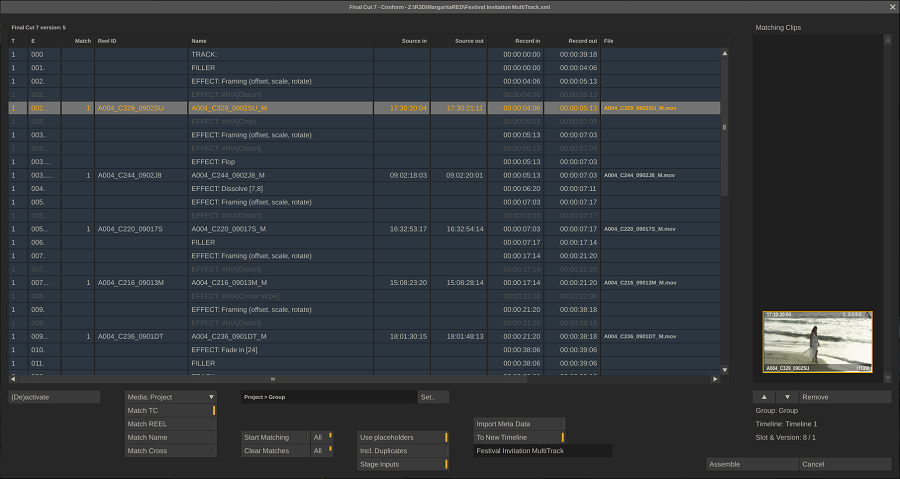
GENERAL
The dialog is very similar to that for an EDL and ALE but there are a number of important differences.
- An AAF or XML can contain multiple tracks; the first column in the data-grid shows the Track of the event.
- The Edit events of an AAF or XML are hierarchically linked: At the lowest level there are one or more Tracks, Shots which can have multiple filters/effects applied to them. The second column of the data-grid shows the event number as well as the hierarchy level.
- Only shot-events have a source-timecode. Track-, Filler- or Effect- events do not.
- SCRATCH does not support all effects/filters that can be included in the AAF or XML. Current supported effects from AAF include: Flip/Flop, Transitions (dissolves, wipes and fades), Vari-Speed (including animation), most Scaling and Offset effects (including animation). Current supported effects from XML include: Flipt/Flop, Transitions and Vari-Speed (no animation). Unsupported events are displayed disabled and cannot be enabled manually. SCRATCH does include all the inputs of non-supported effects on an Assemble and it will display a (pink) annotation with the name of the missing effect.
- The grid's contents are not editable; you cannot change the naming or the timecodes (as that might break the hierarchy).
- The tenth column displays the file reference of a shot if available in the conform file. This file reference can be used for searching directly in a directory for matching shots, rather than matching with clips already loaded in SCRATCH.
- The Metadata column displays the number of name-value pairs available in the conform file (AAF only). This data can be imported using the corresponding button below the grid.
- The last column in the data-grid is reserved for future use.
(De)activate
Allows you to deactivate or activate selected events. De-activated events are not matched and not included in the final assemble. This can be useful if you e.g. want to exclude certain effects or a whole track etc.. When deactivating an event all underlying events will automatically be deactivated too. Events that are deactivated by SCRATCH (such as unsupported effects) can not be activated.
MEDIA OPTIONS
Similar to the EDL matching procedure discussed earlier in this chapter, you first select the location where SCRATCH searches for matching clips and then the criteria for matching: Match Timecode, match on Reel-ID, match on Clip Name or match the Event Reel-ID with the Clip Name (or vice versa) using the Cross option. The media location for an AAF/XML can be:
Project
With the Media:Project option selected, you can additionally limit the scope within the project where SCRATCH will search by selecting a specific Construct, a Group or selecting the Full project by using the Set button and selecting an item from the Project tree selection dialog.

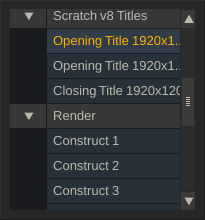
Folder
When selecting the Media:Folder option all match criteria buttons are disabled and a Set and Format Filter control become available to select a folder on disk and set the media type to search for.

The Media:Folder option uses:
- The file reference of the event as displayed in the tenth column. The file reference is stripped of the folder info and the extension.
- The selected folder is search recursively, meaning that all sub-folders are included.
Note that the search from folder might take some time - depending on the size of the folder and sub-folder, the number of matches and the speed of the disk you are searching on. Setting a specific media type increases search / match efficiency and performance. After the match process has finished you can select a different folder to find additional matches.
Reverse Assemble
This option will - similar to an EDL conform - use the clip in the first slot of the current Construct as a match for all events. However, in addition if the AAF contains different tracks the Assemble will look for additional shots on the current Construct; the shot in the second slot will be used to reverse-assemble events on the second track, the shot in the third slot for events in the third track and so on.
File Reference
This option check / uses the shot reference that is in the actual aaf/xml file (last column). Note that this might point to an offline version of the media that was used in the edit - not the original recorded footage.
Matching
The various Match buttons and the Start-, Stop- and Clear-buttons behave the same asdiscussed for the EDL conform earlier in this chapter. Next to the StartMatching button a progress indicator is displayed when the matchingprocess is active.
MATCHING CLIPS
The right part of the dialog is used for displaying matching clips -similar as for the EDL and ALE conform discussed earlier in this chapter. There is a difference however in that the AAF/XML conform will only include the best/bottom match in the final assemble.
ASSEMBLE
Similar to the EDL conform you can assemble to the current or a new Construct. An AAF or XML can have multiple tracks, which are assembled to multiple sub-Constructs/Tracks. After a successful assemble the dialog is closed and the new Construct is selected. If however errors occurred during the assemble the dialog remains open. The top line above the data-grid with the conform info is displayed in red as are the first column event numbers of the events that caused the errors. The Assemble button is disabled to prevent the assembling again to the same Construct inadvertently. To enable the Assemble button again you must close the dialog and reopen it by using the Edit Conform button in the Media menu. Before doing another assemble you first should inspect the failed events and possibly deactivate them.
Use Placeholder
This option will insert a placeholder clip in the timeline for each event that does not have a matched clip tied to it. The placeholder clip will inherit all EDL metadata (timecode, name, reel). With that you can perform a Placeholder conform on those placeholder clips at a later time to update the timeline.
Include Duplicates
This option will put any additional matches as version in the corresponding slot.
Stage Inputs
If SCRATCH encounters an (unsupported) effect with (multiple) inputs this option allows you to have the inputs placed in the staging area of the main input.
Import Meta Data
With an AAF conform you can optionally import and link all available meta-data (name-value pairs) to the matched shot.
Apply CDL
Similar to EDL and ALE, this option will apply any CDL grade information on the color settings of the shot.
To New Timeline
Create a new timeline for the conform - rather than using the current selected timeline.
MATCH AND REPLACE PLACEHOLDER
Each of the EDL, AAF and XML Assemble functions have the option to insert Placeholder nodes when there is no media available with a conform event yet. That way you can already assemble your full timeline and easily update the missing pieces at a later moment. The Match and Replace Placeholder dialog shows you a list of Placeholder in the current Construct / timeline and the functions to match them against media elsewhere in the project of on disk. The various functions are covered later in this chapter. The setup of the dialog is similar to the EDE, AAF and XML functions, the image below only shows the bottom part with the specific Match and Replace options.

Just like with an AAF or XML conform, you select where SCRATCH should look for the media: within the current project or from a external disk. The Match options are also the same as for the other conforms. Note that the Placeholder nodes inherited all meta data from the original conform event: timecode, name, reel-id, etc.
When you Assemble the Placeholder, SCRATCH will replace each Placeholder node with the newly found match. Any grade or framing that was applied to the Placeholder node is applied to the new shot - unless that already has a grade applied.